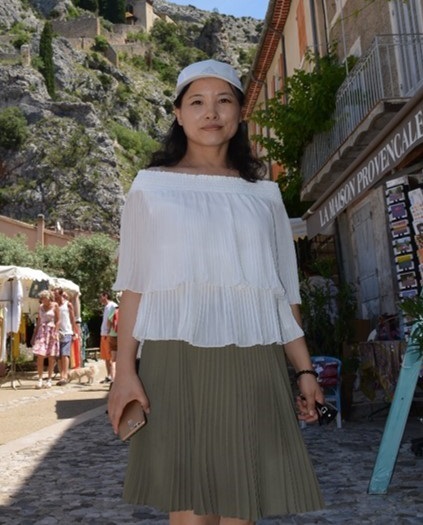The collection of published research on perovskite materials has been growing steadily over the past few years, with certain challenges to their application becoming recurring themes in our submissions inboxes. One key problem facing researchers across all disciplines is that of the instability of perovskite materials to heat and moisture – two conditions they are guaranteed to encounter in most applications.
Many scientists around the world are working on this problem, but Dr. Dongling Ma and her collaborators in China and the USA recently swooped in and presented a possible solution to both moisture and thermal instabilities, now published in the journal Solar RRL (see the story in brief here or the full details here).
Renewable energy is just one branch of Dr. Ma’s research at INRS: her team also investigates the use of functional nanomaterials for biological applications and catalysis. I had the chance to interview both her (DM) and her student, the first author of the Solar RRL paper, Deepak Thrithamarassery Gangadharan (DTG).
Dr. Ma, I believe that you completed your Masters at Zhejiang University (China) and then your doctorate at Rensselaer Polytechnic Institute (USA) before moving to Canada. Have you enjoyed moving around and seeing different places, and getting to know different ways of thinking?
DM: Yes, I really enjoyed moving around and experiencing different cultures. Indeed, that was the reason that I decided to go abroad to do my PhD. I did see much difference in the way of thinking between China and USA, but I do not really see much difference between USA and Canada. Combination of different ways of thinking is helpful in approaching scientific problems, I believe.
Where are your favorite places to just sit and think alone?
DM: Many places, indeed. My backyard deck, my study room, in front of lakes, oceans, etc. They all are my favorite places.
DTG: On a mountain summit, watching the exquisiteness of landscapes and thinking about the inexplicable universe.
Please describe your desks – are they perfectly organized, totally chaotic, or something in between?
DM: It is not perfectly organized, but basically it is fair to say that it is well organized. I can easily find an item on my desk.
DTG: It is something in between. I believe “Chaos is order yet undeciphered,” a line from José Saramago’s Novel, The Double.
When you have time off work, what do you enjoy doing?
DM: Traveling, especially with my families. I also like relaxing at home, reading books, watching movies with my family, playing with our pet, gardening, meeting with friends, etc. There are so much to do and to enjoy in our life, in addition to working.
DTG: I love to do long distance biking in the summer. I enjoy reading, running and playing badminton.
What type of animal best reflects your personality?
DM: Not really sure. Perhaps, dogs.
Dr. Ma, your work covers fundamental research into nanomaterials as well as a very broad range of their potential applications (solar energy conversion, catalysis, biological tracking). How did you get started working on nanomaterials in these fields?
DM: I started to work with nanocomposites when I started my PhD thesis project at Rensselaer Polytechnic Institute (USA). Immediately I got amazed by nanomaterials and their unique properties. During my PhD period, I mainly worked with TiO2 nanoparticles. I conducted their surface modification and integrated them with polymeric materials in order to achieve improved electrical properties. The work eventually led to a patent and several research articles. In parallel, I worked on the self-assembly of nanoparticles into a microscale tube structure, which was published in Appl. Phys. Lett. and also led to an invention and a corresponding patent. I finished my PhD project in 3.5 years. Immediately I was awarded a NSERC Visiting Fellowship to work at the Steacie Institute for Molecular Sciences (Ottawa), National Research Council of Canada, where I continued to work on nanomaterials, but of quite different types. I mostly focused on the development of dye-doped silica nanoparticles and superparamagnetic-core@dye-doped-silica-shell nanoparticles for biomedical applications, leading to several well cited publications. Two and half years later, I was offered an assistant professor position. Realizing the high potential of quantum dots and attracted by strategically important research fields of solar cells and catalysis, I started to pursue new research topics in these areas after I became an assistant professor.
Could you explain your recent findings on perovskite stability for a non-specialist?
DTG: Halide perovskites are a potential low-cost alternative to crystalline silicon for solar cell applications, because it can be made at much lower temperatures. But perovskite devices are very prone to degradation under moisture and heat. In our recent article, we modified halide perovskites and their deposition methods to produce highly stable and efficient perovskite solar cells.
In January, I believe that you entered into a collaboration with researchers at Soochow University, China, to work on a new concept of high-performance solar cells. Can you tell us a little about that project?
DM: Sure. I am very happy to get this grant. In this collaborative project, we plan to join the forces of Quebec and Soochow teams to develop novel, low-cost, high-performance “hybrid” solar cells based on solution processable, high-quality, near-infrared (NIR) quantum dots (QDs) and nanostructured Si, using new concepts emerging from recent advances in nanotechnology.
What other major studies are currently going on in your lab?
DM: My group is basically composed of materials chemists. We like to synthesize our own new nanomaterials or nanostructures and explore them in energy- and biomedicine-related applications. To be more specific, the main research interest of my group consists of the development of various nanoparticles (such as semiconductor quantum dots (QDs), transition metal catalytic nanoparticles, and plasmonic nanostructures of various shapes), 1D nanostructures (such as TiO2 nanorods), 2D nanostructures (such as graphene and C3N4), and nanohybrids/nanocomposites (such as QD-decorated carbon nanotubes, bimetallic core@shell nanoparticles, binary metal oxide nanotubes and graphene-wrapped Cu nanowires) for applications in energy (in particular, solar cells), catalysis (including photocatalysis) and biomedical sectors.
As a scientist and author, would you like to comment on the current state and future directions of scientific publishing?
DM: Please allow me to comment specifically on publications of solar cells: it is good to report a high efficiency. But efficiency is not the only important factor of solar cells and should not be the only target of researchers in this field in order to publish in high-profile journals. Stability is also extremely important and requires significant investigations. In addition, physical insights and fundamental understandings are crucial. We have to move our eyes from “simply high efficiency”.
Could you therefore also comment on the future directions of perovskite solar cell research?
DTG: I am happy and optimistic with the current progress of research on perovskite solar cells. Researchers are able to reproduce high efficiencies at different labs, and double-digit efficiencies for large area perovskite solar cells are significant milestones as far as photovoltaic research is concerned. In the same breath, I am afraid that the commercialization of this technology is going to be challenging unless researchers address the toxicity and stability of perovskite solar cells. In particular, lead-free perovskite solar cells are vital. For example, the European Union stipulates only 0.1% by weight as the maximum allowed concentration of lead in each homogeneous material contained in electronic devices, whereas efficient perovskite solar devices contain more than 10% lead by weight.
If you could give new undergraduate students one piece of advice on their first day, what would you tell them?
DM: Work hard and do not easily give up.
DTG: Apply scientific thinking to solve the problems and never give up.
If you’re interested in perovskite research, take a look at our Perovskite Perspectives series – key problems and solutions outlined by top researchers in the field:
- Perovskite Perspectives: Jingbi You – Stoichiometry for Better Performance
- Perovskite Perspectives: Chul-Ho Lee and Min Jae Ko Discuss Moisture Stability
- Perovskite Perspectives: Yi Hou and Christoph Brabec Talk Hysteresis
Featured Image Credit: Holly Kuchera via Flickr, CC-BY 2.0



















